#also like. great depression in the u.s
Text
i know wwii was a beyond major geopolitical event but it still surprises me how often i come across something that says "and things are this way because WW2"
#thinking about it just makes my head hurt like#the thing they said at least at my school was that it happened because of political alliances and such#but i am extremely certain it was more complicated than that#alic lore#can i be honest though like#my interest in history has mainly avoided major wars or violent conflicts#but also social dynamics make me go crazy (in a mad scientist professor sense) so i kinda wanna look into it now#also obligatory i'm a usian i live in the united states i went to school here for k-12 and also now college#and i know there's propaganda and bullshit in our school curriculum and also that there's a lot of stuff just left out or glossed over#so yeah no shit i'm not properly informed#but also what kind of political bullshit had to be going on for this to affect like. the entire world#secondary question i know there were other places going through shit at the time#like . at least off the top of my head russian revolution and a civil war in spain (which i only know about porque de mi clase de espanol)#also like. great depression in the u.s#i'm sure there's more but there's such a us-centric perspective on history here even in “world history” class. GAHHHHH
1 note
·
View note
Text
I thought y'all should read this
I have a free trial to News+ so I copy-pasted it for you here. I don't think Jonathan Haidt would object to more people having this info.
Tumblr wouldn't let me post it until i removed all the links to Haidt's sources. You'll have to take my word that everything is sourced.
End the Phone-Based Childhood Now
The environment in which kids grow up today is hostile to human development.
By Jonathan Haidt
Something went suddenly and horribly wrong for adolescents in the early 2010s. By now you’ve likely seen the statistics: Rates of depression and anxiety in the United States—fairly stable in the 2000s—rose by more than 50 percent in many studies from 2010 to 2019. The suicide rate rose 48 percent for adolescents ages 10 to 19. For girls ages 10 to 14, it rose 131 percent.
The problem was not limited to the U.S.: Similar patterns emerged around the same time in Canada, the U.K., Australia, New Zealand, the Nordic countries, and beyond. By a variety of measures and in a variety of countries, the members of Generation Z (born in and after 1996) are suffering from anxiety, depression, self-harm, and related disorders at levels higher than any other generation for which we have data.
The decline in mental health is just one of many signs that something went awry. Loneliness and friendlessness among American teens began to surge around 2012. Academic achievement went down, too. According to “The Nation’s Report Card,” scores in reading and math began to decline for U.S. students after 2012, reversing decades of slow but generally steady increase. PISA, the major international measure of educational trends, shows that declines in math, reading, and science happened globally, also beginning in the early 2010s.
As the oldest members of Gen Z reach their late 20s, their troubles are carrying over into adulthood. Young adults are dating less, having less sex, and showing less interest in ever having children than prior generations. They are more likelyto live with their parents. They were less likely to get jobs as teens, and managers say they are harder to work with. Many of these trends began with earlier generations, but most of them accelerated with Gen Z.
Surveys show that members of Gen Z are shyer and more risk averse than previous generations, too, and risk aversion may make them less ambitious. In an interview last May, OpenAI co-founder Sam Altman and Stripe co-founder Patrick Collison noted that, for the first time since the 1970s, none of Silicon Valley’s preeminent entrepreneurs are under 30. “Something has really gone wrong,” Altman said. In a famously young industry, he was baffled by the sudden absence of great founders in their 20s.
Generations are not monolithic, of course. Many young people are flourishing. Taken as a whole, however, Gen Z is in poor mental health and is lagging behind previous generations on many important metrics. And if a generation is doing poorly––if it is more anxious and depressed and is starting families, careers, and important companies at a substantially lower rate than previous generations––then the sociological and economic consequences will be profound for the entire society.

What happened in the early 2010s that altered adolescent development and worsened mental health? Theories abound, but the fact that similar trends are found in many countries worldwide means that events and trends that are specific to the United States cannot be the main story.
I think the answer can be stated simply, although the underlying psychology is complex: Those were the years when adolescents in rich countries traded in their flip phones for smartphones and moved much more of their social lives online—particularly onto social-media platforms designed for virality and addiction. Once young people began carrying the entire internet in their pockets, available to them day and night, it altered their daily experiences and developmental pathways across the board. Friendship, dating, sexuality, exercise, sleep, academics, politics, family dynamics, identity—all were affected. Life changed rapidly for younger children, too, as they began to get access to their parents’ smartphones and, later, got their own iPads, laptops, and even smartphones during elementary school.
As a social psychologist who has long studied social and moral development, I have been involved in debates about the effects of digital technology for years. Typically, the scientific questions have been framed somewhat narrowly, to make them easier to address with data. For example, do adolescents who consume more social media have higher levels of depression? Does using a smartphone just before bedtime interfere with sleep? The answer to these questions is usually found to be yes, although the size of the relationship is often statistically small, which has led some researchers to conclude that these new technologies are not responsible for the gigantic increases in mental illness that began in the early 2010s.
But before we can evaluate the evidence on any one potential avenue of harm, we need to step back and ask a broader question: What is childhood––including adolescence––and how did it change when smartphones moved to the center of it? If we take a more holistic view of what childhood is and what young children, tweens, and teens need to do to mature into competent adults, the picture becomes much clearer. Smartphone-based life, it turns out, alters or interferes with a great number of developmental processes.
The intrusion of smartphones and social media are not the only changes that have deformed childhood. There’s an important backstory, beginning as long ago as the 1980s, when we started systematically depriving children and adolescents of freedom, unsupervised play, responsibility, and opportunities for risk taking, all of which promote competence, maturity, and mental health. But the change in childhood accelerated in the early 2010s, when an already independence-deprived generation was lured into a new virtual universe that seemed safe to parents but in fact is more dangerous, in many respects, than the physical world.
My claim is that the new phone-based childhood that took shape roughly 12 years ago is making young people sick and blocking their progress to flourishing in adulthood. We need a dramatic cultural correction, and we need it now.
1. The Decline of Play and Independence
Human brains are extraordinarily large compared with those of other primates, and human childhoods are extraordinarily long, too, to give those large brains time to wire up within a particular culture. A child’s brain is already 90 percent of its adult size by about age 6. The next 10 or 15 years are about learning norms and mastering skills—physical, analytical, creative, and social. As children and adolescents seek out experiences and practice a wide variety of behaviors, the synapses and neurons that are used frequently are retained while those that are used less often disappear. Neurons that fire together wire together, as brain researchers say.
Brain development is sometimes said to be “experience-expectant,” because specific parts of the brain show increased plasticity during periods of life when an animal’s brain can “expect” to have certain kinds of experiences. You can see this with baby geese, who will imprint on whatever mother-sized object moves in their vicinity just after they hatch. You can see it with human children, who are able to learn languages quickly and take on the local accent, but only through early puberty; after that, it’s hard to learn a language and sound like a native speaker. There is also some evidence of a sensitive period for cultural learning more generally. Japanese children who spent a few years in California in the 1970s came to feel “American” in their identity and ways of interacting only if they attended American schools for a few years between ages 9 and 15. If they left before age 9, there was no lasting impact. If they didn’t arrive until they were 15, it was too late; they didn’t come to feel American.
Human childhood is an extended cultural apprenticeship with different tasks at different ages all the way through puberty. Once we see it this way, we can identify factors that promote or impede the right kinds of learning at each age. For children of all ages, one of the most powerful drivers of learning is the strong motivation to play. Play is the work of childhood, and all young mammals have the same job: to wire up their brains by playing vigorously and often, practicing the moves and skills they’ll need as adults. Kittens will play-pounce on anything that looks like a mouse tail. Human children will play games such as tag and sharks and minnows, which let them practice both their predator skills and their escaping-from-predator skills. Adolescents will play sports with greater intensity, and will incorporate playfulness into their social interactions—flirting, teasing, and developing inside jokes that bond friends together. Hundreds of studies on young rats, monkeys, and humans show that young mammals want to play, need to play, and end up socially, cognitively, and emotionally impaired when they are deprived of play.
One crucial aspect of play is physical risk taking. Children and adolescents must take risks and fail—often—in environments in which failure is not very costly. This is how they extend their abilities, overcome their fears, learn to estimate risk, and learn to cooperate in order to take on larger challenges later. The ever-present possibility of getting hurt while running around, exploring, play-fighting, or getting into a real conflict with another group adds an element of thrill, and thrilling play appears to be the most effective kind for overcoming childhood anxieties and building social, emotional, and physical competence. The desire for risk and thrill increases in the teen years, when failure might carry more serious consequences. Children of all ages need to choose the risk they are ready for at a given moment. Young people who are deprived of opportunities for risk taking and independent exploration will, on average, develop into more anxious and risk-averse adults.
Human childhood and adolescence evolved outdoors, in a physical world full of dangers and opportunities. Its central activities––play, exploration, and intense socializing––were largely unsupervised by adults, allowing children to make their own choices, resolve their own conflicts, and take care of one another. Shared adventures and shared adversity bound young people together into strong friendship clusters within which they mastered the social dynamics of small groups, which prepared them to master bigger challenges and larger groups later on.
And then we changed childhood.
The changes started slowly in the late 1970s and ’80s, before the arrival of the internet, as many parents in the U.S. grew fearful that their children would be harmed or abducted if left unsupervised. Such crimes have always been extremely rare, but they loomed larger in parents’ minds thanks in part to rising levels of street crime combined with the arrival of cable TV, which enabled round-the-clock coverage of missing-children cases. A general decline in social capital––the degree to which people knew and trusted their neighbors and institutions––exacerbated parental fears. Meanwhile, rising competition for college admissions encouraged more intensive forms of parenting. In the 1990s, American parents began pulling their children indoors or insisting that afternoons be spent in adult-run enrichment activities. Free play, independent exploration, and teen-hangout time declined.
In recent decades, seeing unchaperoned children outdoors has become so novel that when one is spotted in the wild, some adults feel it is their duty to call the police. In 2015, the Pew Research Center found that parents, on average, believed that children should be at least 10 years old to play unsupervised in front of their house, and that kids should be 14 before being allowed to go unsupervised to a public park. Most of these same parents had enjoyed joyous and unsupervised outdoor play by the age of 7 or 8.
2. The Virtual World Arrives in Two Waves
The internet, which now dominates the lives of young people, arrived in two waves of linked technologies. The first one did little harm to Millennials. The second one swallowed Gen Z whole.
The first wave came ashore in the 1990s with the arrival of dial-up internet access, which made personal computers good for something beyond word processing and basic games. By 2003, 55 percent of American households had a computer with (slow) internet access. Rates of adolescent depression, loneliness, and other measures of poor mental health did not rise in this first wave. If anything, they went down a bit. Millennial teens (born 1981 through 1995), who were the first to go through puberty with access to the internet, were psychologically healthier and happier, on average, than their older siblings or parents in Generation X (born 1965 through 1980).
The second wave began to rise in the 2000s, though its full force didn’t hit until the early 2010s. It began rather innocently with the introduction of social-media platforms that helped people connect with their friends. Posting and sharing content became much easier with sites such as Friendster (launched in 2003), Myspace (2003), and Facebook (2004).
Teens embraced social media soon after it came out, but the time they could spend on these sites was limited in those early years because the sites could only be accessed from a computer, often the family computer in the living room. Young people couldn’t access social media (and the rest of the internet) from the school bus, during class time, or while hanging out with friends outdoors. Many teens in the early-to-mid-2000s had cellphones, but these were basic phones (many of them flip phones) that had no internet access. Typing on them was difficult––they had only number keys. Basic phones were tools that helped Millennials meet up with one another in person or talk with each other one-on-one. I have seen no evidence to suggest that basic cellphones harmed the mental health of Millennials.
It was not until the introduction of the iPhone (2007), the App Store (2008), and high-speed internet (which reached 50 percent of American homes in 2007)—and the corresponding pivot to mobile made by many providers of social media, video games, and porn—that it became possible for adolescents to spend nearly every waking moment online. The extraordinary synergy among these innovations was what powered the second technological wave. In 2011, only 23 percent of teens had a smartphone. By 2015, that number had risen to 73 percent, and a quarter of teens said they were online “almost constantly.” Their younger siblings in elementary school didn’t usually have their own smartphones, but after its release in 2010, the iPad quickly became a staple of young children’s daily lives. It was in this brief period, from 2010 to 2015, that childhood in America (and many other countries) was rewired into a form that was more sedentary, solitary, virtual, and incompatible with healthy human development.
3. Techno-optimism and the Birth of the Phone-Based Childhood
The phone-based childhood created by that second wave—including not just smartphones themselves, but all manner of internet-connected devices, such as tablets, laptops, video-game consoles, and smartwatches—arrived near the end of a period of enormous optimism about digital technology. The internet came into our lives in the mid-1990s, soon after the fall of the Soviet Union. By the end of that decade, it was widely thought that the web would be an ally of democracy and a slayer of tyrants. When people are connected to each other, and to all the information in the world, how could any dictator keep them down?
In the 2000s, Silicon Valley and its world-changing inventions were a source of pride and excitement in America. Smart and ambitious young people around the world wanted to move to the West Coast to be part of the digital revolution. Tech-company founders such as Steve Jobs and Sergey Brin were lauded as gods, or at least as modern Prometheans, bringing humans godlike powers. The Arab Spring bloomed in 2011 with the help of decentralized social platforms, including Twitter and Facebook. When pundits and entrepreneurs talked about the power of social media to transform society, it didn’t sound like a dark prophecy.
You have to put yourself back in this heady time to understand why adults acquiesced so readily to the rapid transformation of childhood. Many parents had concerns, even then, about what their children were doing online, especially because of the internet’s ability to put children in contact with strangers. But there was also a lot of excitement about the upsides of this new digital world. If computers and the internet were the vanguards of progress, and if young people––widely referred to as “digital natives”––were going to live their lives entwined with these technologies, then why not give them a head start? I remember how exciting it was to see my 2-year-old son master the touch-and-swipe interface of my first iPhone in 2008. I thought I could see his neurons being woven together faster as a result of the stimulation it brought to his brain, compared to the passivity of watching television or the slowness of building a block tower. I thought I could see his future job prospects improving.
Touchscreen devices were also a godsend for harried parents. Many of us discovered that we could have peace at a restaurant, on a long car trip, or at home while making dinner or replying to emails if we just gave our children what they most wanted: our smartphones and tablets. We saw that everyone else was doing it and figured it must be okay.
It was the same for older children, desperate to join their friends on social-media platforms, where the minimum age to open an account was set by law to 13, even though no research had been done to establish the safety of these products for minors. Because the platforms did nothing (and still do nothing) to verify the stated age of new-account applicants, any 10-year-old could open multiple accounts without parental permission or knowledge, and many did. Facebook and later Instagram became places where many sixth and seventh graders were hanging out and socializing. If parents did find out about these accounts, it was too late. Nobody wanted their child to be isolated and alone, so parents rarely forced their children to shut down their accounts.
We had no idea what we were doing.
4. The High Cost of a Phone-Based Childhood
In Walden, his 1854 reflection on simple living, Henry David Thoreau wrote, “The cost of a thing is the amount of … life which is required to be exchanged for it, immediately or in the long run.” It’s an elegant formulation of what economists would later call the opportunity cost of any choice—all of the things you can no longer do with your money and time once you’ve committed them to something else. So it’s important that we grasp just how much of a young person’s day is now taken up by their devices.
The numbers are hard to believe. The most recent Gallup data show that American teens spend about five hours a day just on social-media platforms (including watching videos on TikTok and YouTube). Add in all the other phone- and screen-based activities, and the number rises to somewhere between seven and nine hours a day, on average. The numbers are even higher in single-parent and low-income families, and among Black, Hispanic, and Native American families.
In Thoreau’s terms, how much of life is exchanged for all this screen time? Arguably, most of it. Everything else in an adolescent’s day must get squeezed down or eliminated entirely to make room for the vast amount of content that is consumed, and for the hundreds of “friends,” “followers,” and other network connections that must be serviced with texts, posts, comments, likes, snaps, and direct messages. I recently surveyed my students at NYU, and most of them reported that the very first thing they do when they open their eyes in the morning is check their texts, direct messages, and social-media feeds. It’s also the last thing they do before they close their eyes at night. And it’s a lot of what they do in between.
The amount of time that adolescents spend sleeping declined in the early 2010s, and many studies tie sleep loss directly to the use of devices around bedtime, particularly when they’re used to scroll through social media. Exercise declined, too, which is unfortunate because exercise, like sleep, improves both mental and physical health. Book reading has been declining for decades, pushed aside by digital alternatives, but the decline, like so much else, sped up in the early 2010s. With passive entertainment always available, adolescent minds likely wander less than they used to; contemplation and imagination might be placed on the list of things winnowed down or crowded out.
But perhaps the most devastating cost of the new phone-based childhood was the collapse of time spent interacting with other people face-to-face. A study of how Americans spend their time found that, before 2010, young people (ages 15 to 24) reported spending far more time with their friends (about two hours a day, on average, not counting time together at school) than did older people (who spent just 30 to 60 minutes with friends). Time with friends began decreasing for young people in the 2000s, but the drop accelerated in the 2010s, while it barely changed for older people. By 2019, young people’s time with friends had dropped to just 67 minutes a day. It turns out that Gen Z had been socially distancing for many years and had mostly completed the project by the time COVID-19 struck.
You might question the importance of this decline. After all, isn’t much of this online time spent interacting with friends through texting, social media, and multiplayer video games? Isn’t that just as good?
Some of it surely is, and virtual interactions offer unique benefits too, especially for young people who are geographically or socially isolated. But in general, the virtual world lacks many of the features that make human interactions in the real world nutritious, as we might say, for physical, social, and emotional development. In particular, real-world relationships and social interactions are characterized by four features—typical for hundreds of thousands of years—that online interactions either distort or erase.
First, real-world interactions are embodied, meaning that we use our hands and facial expressions to communicate, and we learn to respond to the body language of others. Virtual interactions, in contrast, mostly rely on language alone. No matter how many emojis are offered as compensation, the elimination of communication channels for which we have eons of evolutionary programming is likely to produce adults who are less comfortable and less skilled at interacting in person.
Second, real-world interactions are synchronous; they happen at the same time. As a result, we learn subtle cues about timing and conversational turn taking. Synchronous interactions make us feel closer to the other person because that’s what getting “in sync” does. Texts, posts, and many other virtual interactions lack synchrony. There is less real laughter, more room for misinterpretation, and more stress after a comment that gets no immediate response.
Third, real-world interactions primarily involve one‐to‐one communication, or sometimes one-to-several. But many virtual communications are broadcast to a potentially huge audience. Online, each person can engage in dozens of asynchronous interactions in parallel, which interferes with the depth achieved in all of them. The sender’s motivations are different, too: With a large audience, one’s reputation is always on the line; an error or poor performance can damage social standing with large numbers of peers. These communications thus tend to be more performative and anxiety-inducing than one-to-one conversations.
Finally, real-world interactions usually take place within communities that have a high bar for entry and exit, so people are strongly motivated to invest in relationships and repair rifts when they happen. But in many virtual networks, people can easily block others or quit when they are displeased. Relationships within such networks are usually more disposable.
These unsatisfying and anxiety-producing features of life online should be recognizable to most adults. Online interactions can bring out antisocial behavior that people would never display in their offline communities. But if life online takes a toll on adults, just imagine what it does to adolescents in the early years of puberty, when their “experience expectant” brains are rewiring based on feedback from their social interactions.
Kids going through puberty online are likely to experience far more social comparison, self-consciousness, public shaming, and chronic anxiety than adolescents in previous generations, which could potentially set developing brains into a habitual state of defensiveness. The brain contains systems that are specialized for approach (when opportunities beckon) and withdrawal (when threats appear or seem likely). People can be in what we might call “discover mode” or “defend mode” at any moment, but generally not both. The two systems together form a mechanism for quickly adapting to changing conditions, like a thermostat that can activate either a heating system or a cooling system as the temperature fluctuates. Some people’s internal thermostats are generally set to discover mode, and they flip into defend mode only when clear threats arise. These people tend to see the world as full of opportunities. They are happier and less anxious. Other people’s internal thermostats are generally set to defend mode, and they flip into discover mode only when they feel unusually safe. They tend to see the world as full of threats and are more prone to anxiety and depressive disorders.

A simple way to understand the differences between Gen Z and previous generations is that people born in and after 1996 have internal thermostats that were shifted toward defend mode. This is why life on college campuses changed so suddenly when Gen Z arrived, beginning around 2014. Students began requesting “safe spaces” and trigger warnings. They were highly sensitive to “microaggressions” and sometimes claimed that words were “violence.” These trends mystified those of us in older generations at the time, but in hindsight, it all makes sense. Gen Z students found words, ideas, and ambiguous social encounters more threatening than had previous generations of students because we had fundamentally altered their psychological development.
5. So Many Harms
The debate around adolescents’ use of smartphones and social media typically revolves around mental health, and understandably so. But the harms that have resulted from transforming childhood so suddenly and heedlessly go far beyondmental health. I’ve touched on some of them—social awkwardness, reduced self-confidence, and a more sedentary childhood. Here are three additional harms.
Fragmented Attention, Disrupted Learning
Staying on task while sitting at a computer is hard enough for an adult with a fully developed prefrontal cortex. It is far more difficult for adolescents in front of their laptop trying to do homework. They are probably less intrinsically motivated to stay on task. They’re certainly less able, given their undeveloped prefrontal cortex, and hence it’s easy for any company with an app to lure them away with an offer of social validation or entertainment. Their phones are pinging constantly—one study found that the typical adolescent now gets 237 notifications a day, roughly 15 every waking hour. Sustained attention is essential for doing almost anything big, creative, or valuable, yet young people find their attention chopped up into little bits by notifications offering the possibility of high-pleasure, low-effort digital experiences.
It even happens in the classroom. Studies confirm that when students have access to their phones during class time, they use them, especially for texting and checking social media, and their grades and learning suffer. This might explain why benchmark test scores began to decline in the U.S. and around the world in the early 2010s—well before the pandemic hit.
Addiction and Social Withdrawal
The neural basis of behavioral addiction to social media or video games is not exactly the same as chemical addiction to cocaine or opioids. Nonetheless, they all involve abnormally heavy and sustained activation of dopamine neurons and reward pathways. Over time, the brain adapts to these high levels of dopamine; when the child is not engaged in digital activity, their brain doesn’t have enough dopamine, and the child experiences withdrawal symptoms. These generally include anxiety, insomnia, and intense irritability. Kids with these kinds of behavioral addictions often become surly and aggressive, and withdraw from their families into their bedrooms and devices.
Social-media and gaming platforms were designed to hook users. How successful are they? How many kids suffer from digital addictions?
The main addiction risks for boys seem to be video games and porn. “Internet gaming disorder,” which was added to the main diagnosis manual of psychiatry in 2013 as a condition for further study, describes “significant impairment or distress” in several aspects of life, along with many hallmarks of addiction, including an inability to reduce usage despite attempts to do so. Estimates for the prevalence of IGD range from 7 to 15 percent among adolescent boys and young men. As for porn, a nationally representative survey of American adults published in 2019 found that 7 percent of American men agreed or strongly agreed with the statement “I am addicted to pornography”—and the rates were higher for the youngest men.
Girls have much lower rates of addiction to video games and porn, but they use social media more intensely than boys do. A study of teens in 29 nations found that between 5 and 15 percent of adolescents engage in what is called “problematic social media use,” which includes symptoms such as preoccupation, withdrawal symptoms, neglect of other areas of life, and lying to parents and friends about time spent on social media. That study did not break down results by gender, but many others have found that rates of “problematic use” are higher for girls.
I don’t want to overstate the risks: Most teens do not become addicted to their phones and video games. But across multiple studies and across genders, rates of problematic use come out in the ballpark of 5 to 15 percent. Is there any other consumer product that parents would let their children use relatively freely if they knew that something like one in 10 kids would end up with a pattern of habitual and compulsive use that disrupted various domains of life and looked a lot like an addiction?
The Decay of Wisdom and the Loss of Meaning
During that crucial sensitive period for cultural learning, from roughly ages 9 through 15, we should be especially thoughtful about who is socializing our children for adulthood. Instead, that’s when most kids get their first smartphone and sign themselves up (with or without parental permission) to consume rivers of content from random strangers. Much of that content is produced by other adolescents, in blocks of a few minutes or a few seconds.
This rerouting of enculturating content has created a generation that is largely cut off from older generations and, to some extent, from the accumulated wisdom of humankind, including knowledge about how to live a flourishing life. Adolescents spend less time steeped in their local or national culture. They are coming of age in a confusing, placeless, ahistorical maelstrom of 30-second stories curated by algorithms designed to mesmerize them. Without solid knowledge of the past and the filtering of good ideas from bad––a process that plays out over many generations––young people will be more prone to believe whatever terrible ideas become popular around them, which might explain why videos showing young people reacting positively to Osama bin Laden’s thoughts about America were trending on TikTok last fall.
All this is made worse by the fact that so much of digital public life is an unending supply of micro dramas about somebody somewhere in our country of 340 million people who did something that can fuel an outrage cycle, only to be pushed aside by the next. It doesn’t add up to anything and leaves behind only a distorted sense of human nature and affairs.
When our public life becomes fragmented, ephemeral, and incomprehensible, it is a recipe for anomie, or normlessness. The great French sociologist Émile Durkheim showed long ago that a society that fails to bind its people together with some shared sense of sacredness and common respect for rules and norms is not a society of great individual freedom; it is, rather, a place where disoriented individuals have difficulty setting goals and exerting themselves to achieve them. Durkheim argued that anomie was a major driver of suicide rates in European countries. Modern scholars continue to draw on his work to understand suicide rates today.
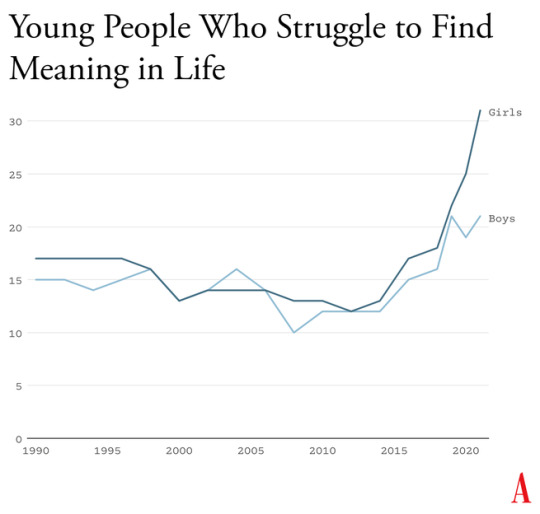
Durkheim’s observations are crucial for understanding what happened in the early 2010s. A long-running survey of American teens found that, from 1990 to 2010, high-school seniors became slightly less likely to agree with statements such as “Life often feels meaningless.” But as soon as they adopted a phone-based life and many began to live in the whirlpool of social media, where no stability can be found, every measure of despair increased. From 2010 to 2019, the number who agreed that their lives felt “meaningless” increased by about 70 percent, to more than one in five.
6. Young People Don’t Like Their Phone-Based Lives
How can I be confident that the epidemic of adolescent mental illness was kicked off by the arrival of the phone-based childhood? Skeptics point to other events as possible culprits, including the 2008 global financial crisis, global warming, the 2012 Sandy Hook school shooting and the subsequent active-shooter drills, rising academic pressures, and the opioid epidemic. But while these events might have been contributing factors in some countries, none can explain both the timing and international scope of the disaster.
An additional source of evidence comes from Gen Z itself. With all the talk of regulating social media, raising age limits, and getting phones out of schools, you might expect to find many members of Gen Z writing and speaking out in opposition. I’ve looked for such arguments and found hardly any. In contrast, many young adults tell stories of devastation.
Freya India, a 24-year-old British essayist who writes about girls, explains how social-media sites carry girls off to unhealthy places: “It seems like your child is simply watching some makeup tutorials, following some mental health influencers, or experimenting with their identity. But let me tell you: they are on a conveyor belt to someplace bad. Whatever insecurity or vulnerability they are struggling with, they will be pushed further and further into it.” She continues:
Gen Z were the guinea pigs in this uncontrolled global social experiment. We were the first to have our vulnerabilities and insecurities fed into a machine that magnified and refracted them back at us, all the time, before we had any sense of who we were. We didn’t just grow up with algorithms. They raised us. They rearranged our faces. Shaped our identities. Convinced us we were sick.
Rikki Schlott, a 23-year-old American journalist and co-author of The Canceling of the American Mind, writes,
"The day-to-day life of a typical teen or tween today would be unrecognizable to someone who came of age before the smartphone arrived. Zoomers are spending an average of 9 hours daily in this screen-time doom loop—desperate to forget the gaping holes they’re bleeding out of, even if just for … 9 hours a day. Uncomfortable silence could be time to ponder why they’re so miserable in the first place. Drowning it out with algorithmic white noise is far easier."
A 27-year-old man who spent his adolescent years addicted (his word) to video games and pornography sent me this reflection on what that did to him:
I missed out on a lot of stuff in life—a lot of socialization. I feel the effects now: meeting new people, talking to people. I feel that my interactions are not as smooth and fluid as I want. My knowledge of the world (geography, politics, etc.) is lacking. I didn’t spend time having conversations or learning about sports. I often feel like a hollow operating system.
Or consider what Facebook found in a research project involving focus groups of young people, revealed in 2021 by the whistleblower Frances Haugen: “Teens blame Instagram for increases in the rates of anxiety and depression among teens,” an internal document said. “This reaction was unprompted and consistent across all groups.”
7. Collective-Action Problems
Social-media companies such as Meta, TikTok, and Snap are often compared to tobacco companies, but that’s not really fair to the tobacco industry. It’s true that companies in both industries marketed harmful products to children and tweaked their products for maximum customer retention (that is, addiction), but there’s a big difference: Teens could and did choose, in large numbers, not to smoke. Even at the peak of teen cigarette use, in 1997, nearly two-thirds of high-school students did not smoke.
Social media, in contrast, applies a lot more pressure on nonusers, at a much younger age and in a more insidious way. Once a few students in any middle school lie about their age and open accounts at age 11 or 12, they start posting photos and comments about themselves and other students. Drama ensues. The pressure on everyone else to join becomes intense. Even a girl who knows, consciously, that Instagram can foster beauty obsession, anxiety, and eating disorders might sooner take those risks than accept the seeming certainty of being out of the loop, clueless, and excluded. And indeed, if she resists while most of her classmates do not, she might, in fact, be marginalized, which puts her at risk for anxiety and depression, though via a different pathway than the one taken by those who use social media heavily. In this way, social media accomplishes a remarkable feat: It even harms adolescents who do not use it.
A recent study led by the University of Chicago economist Leonardo Bursztyn captured the dynamics of the social-media trap precisely. The researchers recruited more than 1,000 college students and asked them how much they’d need to be paid to deactivate their accounts on either Instagram or TikTok for four weeks. That’s a standard economist’s question to try to compute the net value of a product to society. On average, students said they’d need to be paid roughly $50 ($59 for TikTok, $47 for Instagram) to deactivate whichever platform they were asked about. Then the experimenters told the students that they were going to try to get most of the others in their school to deactivate that same platform, offering to pay them to do so as well, and asked, Now how much would you have to be paid to deactivate, if most others did so? The answer, on average, was less than zero. In each case, most students were willing to pay to have that happen.
Social media is all about network effects. Most students are only on it because everyone else is too. Most of them would prefer that nobody be on these platforms. Later in the study, students were asked directly, “Would you prefer to live in a world without Instagram [or TikTok]?” A majority of students said yes––58 percent for each app.
This is the textbook definition of what social scientists call a collective-action problem. It’s what happens when a group would be better off if everyone in the group took a particular action, but each actor is deterred from acting, because unless the others do the same, the personal cost outweighs the benefit. Fishermen considering limiting their catch to avoid wiping out the local fish population are caught in this same kind of trap. If no one else does it too, they just lose profit.
Cigarettes trapped individual smokers with a biological addiction. Social media has trapped an entire generation in a collective-action problem. Early app developers deliberately and knowingly exploited the psychological weaknesses and insecurities of young people to pressure them to consume a product that, upon reflection, many wish they could use less, or not at all.
8. Four Norms to Break Four Traps
Young people and their parents are stuck in at least four collective-action traps. Each is hard to escape for an individual family, but escape becomes much easier if families, schools, and communities coordinate and act together. Here are four norms that would roll back the phone-based childhood. I believe that any community that adopts all four will see substantial improvements in youth mental health within two years.
No smartphones before high school
The trap here is that each child thinks they need a smartphone because “everyone else” has one, and many parents give in because they don’t want their child to feel excluded. But if no one else had a smartphone—or even if, say, only half of the child’s sixth-grade class had one—parents would feel more comfortable providing a basic flip phone (or no phone at all). Delaying round-the-clock internet access until ninth grade (around age 14) as a national or community norm would help to protect adolescents during the very vulnerable first few years of puberty. According to a 2022 British study, these are the years when social-media use is most correlated with poor mental health. Family policies about tablets, laptops, and video-game consoles should be aligned with smartphone restrictions to prevent overuse of other screen activities.
No social media before 16
The trap here, as with smartphones, is that each adolescent feels a strong need to open accounts on TikTok, Instagram, Snapchat, and other platforms primarily because that’s where most of their peers are posting and gossiping. But if the majority of adolescents were not on these accounts until they were 16, families and adolescents could more easily resist the pressure to sign up. The delay would not mean that kids younger than 16 could never watch videos on TikTok or YouTube—only that they could not open accounts, give away their data, post their own content, and let algorithms get to know them and their preferences.
Phone‐free schools
Most schools claim that they ban phones, but this usually just means that students aren’t supposed to take their phone out of their pocket during class. Research shows that most students do use their phones during class time. They also use them during lunchtime, free periods, and breaks between classes––times when students could and should be interacting with their classmates face-to-face. The only way to get students’ minds off their phones during the school day is to require all students to put their phones (and other devices that can send or receive texts) into a phone locker or locked pouch at the start of the day. Schools that have gone phone-free always seem to report that it has improved the culture, making students more attentive in class and more interactive with one another. Published studies back them up.
More independence, free play, and responsibility in the real world
Many parents are afraid to give their children the level of independence and responsibility they themselves enjoyed when they were young, even though rates of homicide, drunk driving, and other physical threats to children are way down in recent decades. Part of the fear comes from the fact that parents look at each other to determine what is normal and therefore safe, and they see few examples of families acting as if a 9-year-old can be trusted to walk to a store without a chaperone. But if many parents started sending their children out to play or run errands, then the norms of what is safe and accepted would change quickly. So would ideas about what constitutes “good parenting.” And if more parents trusted their children with more responsibility––for example, by asking their kids to do more to help out, or to care for others––then the pervasive sense of uselessness now found in surveys of high-school students might begin to dissipate.
It would be a mistake to overlook this fourth norm. If parents don’t replace screen time with real-world experiences involving friends and independent activity, then banning devices will feel like deprivation, not the opening up of a world of opportunities.
The main reason why the phone-based childhood is so harmful is because it pushes aside everything else. Smartphones are experience blockers. Our ultimate goal should not be to remove screens entirely, nor should it be to return childhood to exactly the way it was in 1960. Rather, it should be to create a version of childhood and adolescence that keeps young people anchored in the real world while flourishing in the digital age.
9. What Are We Waiting For?
An essential function of government is to solve collective-action problems. Congress could solve or help solve the ones I’ve highlighted—for instance, by raising the age of “internet adulthood” to 16 and requiring tech companies to keep underage children off their sites.
In recent decades, however, Congress has not been good at addressing public concerns when the solutions would displease a powerful and deep-pocketed industry. Governors and state legislators have been much more effective, and their successes might let us evaluate how well various reforms work. But the bottom line is that to change norms, we’re going to need to do most of the work ourselves, in neighborhood groups, schools, and other communities.
There are now hundreds of organizations––most of them started by mothers who saw what smartphones had done to their children––that are working to roll back the phone-based childhood or promote a more independent, real-world childhood. (I have assembled a list of many of them.) One that I co-founded, at LetGrow.org, suggests a variety of simple programs for parents or schools, such as play club (schools keep the playground open at least one day a week before or after school, and kids sign up for phone-free, mixed-age, unstructured play as a regular weekly activity) and the Let Grow Experience (a series of homework assignments in which students––with their parents’ consent––choose something to do on their own that they’ve never done before, such as walk the dog, climb a tree, walk to a store, or cook dinner).
Parents are fed up with what childhood has become. Many are tired of having daily arguments about technologies that were designed to grab hold of their children’s attention and not let go. But the phone-based childhood is not inevitable.
The four norms I have proposed cost almost nothing to implement, they cause no clear harm to anyone, and while they could be supported by new legislation, they can be instilled even without it. We can begin implementing all of them right away, this year, especially in communities with good cooperation between schools and parents. A single memo from a principal asking parents to delay smartphones and social media, in support of the school’s effort to improve mental health by going phone free, would catalyze collective action and reset the community’s norms.
We didn’t know what we were doing in the early 2010s. Now we do. It’s time to end the phone-based childhood.
This article is adapted from Jonathan Haidt’s forthcoming book, The Anxious Generation: How the Great Rewiring of Childhood Is Causing an Epidemic of Mental Illness.
218 notes
·
View notes
Text
tuesday again 8/27/2024
every fucking time i step outside the apartment i get smacked in the face with a wet blanket of heat and humidity. this is my second summer in the swamp WHY am i so startled every single time
listening
both off my spotify recommended list: 2 Mello's dead leaves, a funky little instrumental that sounds like driving somewhere with fitful AC when it is so hot the leaves are dropping off the trees.
TV Girl's Taking What's Not Yours is not a song i wholeheartedly enjoy, but the sample of Nixon saying "I am not a crook!" has been stuck in my head all week. and stickiness in the head is the main criteria for a tuesdaysong. i don't know anything about this band but my brother said "you WOULD be the typical TV Girl listener". so that information is now available to everyone.
indie pop with indie frontman voice (get well soon). actually. no. this singer reminds me of shelby the worm from adventure time. plus distinct funk overtones. 70% of the song by volume is a hip-hop-ified sample of an anti-pirating PSA. i think i would probably like this when i am less depressed.
-
reading
really great breakdown of what the fuck is happening with Telegram and why conservatives are so riled up about it.
The quick version of how Telegram became a part of the culture war goes something like this. In April, Uri Berliner, who was then a senior business editor at NPR, alleged a widespread culture of woke at NPR in Bari Weiss’s The Free Press. This led to weeks of discussion about NPR on Twitter and in the right-wing blogosphere. During this saga, several right-wing bloggers attacked NPR’s current CEO and President Katherine Maher, who was previously the CEO of the Wikimedia Foundation, an organization that has been repeatedly attacked by conservatives, Elon Musk, etc. for allegedly having a liberal bias. Maher is also a member of the Signal Foundation’s board of directors.
this fascinated me as an engineering/infrastructure disaster in process. thanks longreads
Nearly wherever you look, border politics in the United States is animated by a persistent myth: that with enough money and willpower, you could eventually seal off the countries from one another, like apartments that share a 1,954-mile wall. One way to describe decades of militarization on the border is that it serves to make Mexico invisible to residents of the United States. The same might be said of cross-border industrial development: porous to money and airplane parts, hardened to everything else. Straddling one of the busiest land crossings in the world, the Tijuana River offers a stubborn rebuttal, a reminder that both sides of the border constitute a single place. Once the poop is in the water, no amount of barbed wire can get it out.
-
watching
i have watched about a movie a day this week and nothing has like. hit.

The Sisters Brothers (2018, dir. Audiard) was simply not the vibe i was looking for. somewhere between coen brothers and peckinpah. not that i am expecting all movies to have an easily portable moral message delivered to me fortune-cookie style in a silent-film dialogue screen right before the credits play, but what was this About. what was the Story being conveyed to me. this was like an episode of the twilight zone where rod serling goes "damn well that was fucked up" except i went in expecting like. a drama. it's a beautiful movie with great acting except they forgot to put a feature-length-movie plot in it.
youtube
Omega Doom (1996, dir. Pyun) is such a strange thing. a cyber-Yojimbo with Rutger Hauer. takes place almost completely within one blasted, snowy little town plaza. Rutger Hauer got "shot in the program" during the great human/robot war and it turned him good.
i think it was marketed very poorly, bc it is NOT an epic science fiction thriller. it was made for about five dollars and is a very talky, meandering, weird little cyber-western. as is the case for all movies with female robots, a lot of weird anxieties about women. i think it would have been way more interesting with a completely genderflipped cast? like push that concept all the way! watching mr hauer mow down a lot of fembots was not the most pleasant experience for me as an alleged woman.
not as good as A Fistful of Dollars but compels me more.
-
playing
hello this is very important. the fallout classic collection will be free on epic starting thursday. thank you for your time.
new major genshin patch this week so i will not shut up about that for a bit. as of time of drafting this i am down to TWENTY SEVEN map markers and fully half of them are card game opponents i haven't beaten.
youtube
i want to be a point and click adventure game girl so bad but i am afraid i do not have the point and click adventure game temperament. i am having fun with The Silent Age, a little postapoc thing with a time travel mechanic, but only through heavy reference to a walkthrough. this was free on epic last march and i kind of get why? it was published in 2012, wasn't part of a series and didn't have ongoing monetization, and reviewed well but doesn't have a ton of replayability. probably a great windfall for the studio of like $10k, im curious how many people actually downloaded it during its free week. the kind of self-contained game i personally am glad exists in the world but don't want to pay money for.
some good graph humor.

some good osha humor.
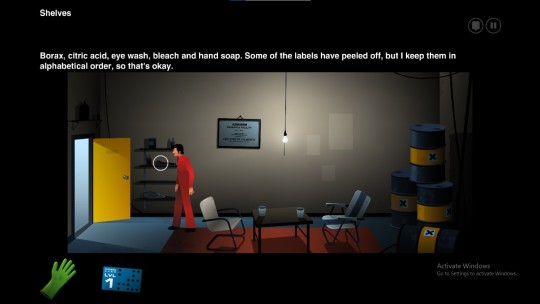
-
making
i love to acquire a container. this tiny little pearlescent blue avon bath oil holder (i thought was a vase in texas thrift but that explains why it was horrifyingly sticky) now holds my double pointed needles and other knitting bits and bobs so they're not buried at the bottom of the vase with the regular needles
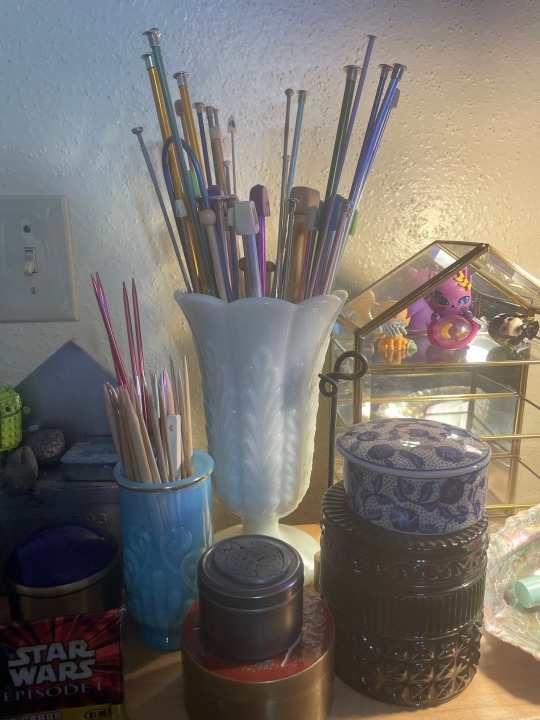
27 notes
·
View notes
Text
Interview With a Writer

It is that blessed time when the wonderful and talented Miss Maggie, @inthedayswhenlandswerefew, gives us some behind-the-scenes insight to her latest brilliant narration. [Feel free to check out the Spotify playlist of all the songs mentioned and let me know if I forgot one!]
Here is masterlist to my Interview With a Writer series and the other talented individuals who allow me to continue this self-indulgent series! 💜 Picture(s) source.

Name: inthedayswhenlandswerefew
Story: 1968
Paring: modern Aemond Targaryen x female!reader, modern Aegon Targaryen x female!reader
Warnings: 18+ mature themes. Be mindful of chapter warnings.
Where did the idea for 1968 come from?
I am a high school social studies teacher by trade, and my absolute favorite class to teach is American History. The 1960s and 70s were actually one of my weak spots when I got my first teaching job back in 2020, so I ended up researching a lot about that period of time and got absolutely obsessed with it. In my American History class, I spend a whole lesson on JUST 1968, because so many important events happened in that year that are emblematic of broader trends and tensions.
One day I was re-reading one of my favorite books, The Other Mrs. Kennedy by Jerry Oppenheimer, which is specifically about Bobby Kennedy’s wife Ethel, but also gives a lot of insight into the Kennedy family generally and what it was like to live through that era. The idea of using this setting as a fic AU occurred to me, and I ruminated on it for a few weeks while finishing up Napoleonville.
Eventually, I had a revelation of the ending of 1968 (true to my usual pattern), and then knew I’d have to write the fic! I was actually really worried about all the political and historical details being too boring and/or confusing (especially for non-U.S. readers), so I was relieved that so many people gave it a chance. 🥰
Honestly, it was brilliant with the similarities to the Kennedys and Targaryens in the story. Were there any historical cameos in 1968 that you enjoyed channeling? Or perhaps struggled with?
I find LBJ super fascinating, and I feel that because of the Vietnam War he really doesn’t get a fair assessment when people look back on his presidency. His work for civil rights and the Great Society (SNAP, Medicaid, Head Start, Job Corps, PBS, etc.) was truly revolutionary, and as someone who grew up in poverty and benefitted from a lot of those programs, I don’t think LBJ’s contributions get the recognition and praise they deserve. I perceive him as a haunted sort of figure, and I really enjoyed his cameos. (To be clear, he was also super problematic and bizarre personally, and I don’t mean to excuse any of that 😂).
As for someone who was difficult to write about…honestly, the George Wallace research I did was super depressing, so while he was necessary to include, I didn’t really enjoy working on those parts!
Was there anything in specific that inspired your Reader portrayal?
Io is a bit of a composite sketch. Ethel Kennedy was known as doggedly committed to her husband’s career above all else (despite eventually being the mother of 11 children!!), and I think that inspired Io’s single-minded determination to help Aemond win the election in the first few chapters. Ethel was traditional in the sense that her husband was the center of her world and made all the important decisions, as was expected of women of her social class in that time period. But Io is also a manifestation of the counterculture of the late-60s. She is young, educated, genuinely progressive politically, and likes to party. She tries to reconcile the expectations of her family/time period and her actual personality by intentionally choosing a husband with whom she can have an equal partnership making the world a better place. And…we all know how that worked out.
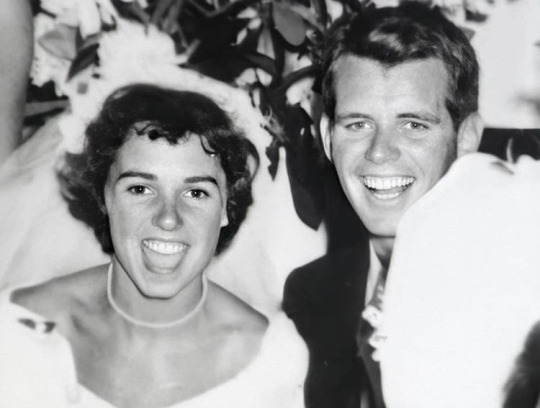
[Photo Ethel and Bobby Kennedy, m. 1950]
Can you explain your interpretation of Aegon? How does he compare and contrast to Aemond? What drives them? Why are they the way that they are?
In 1968, Aegon is 40 years old, and so his role in the Targaryen political dynasty is very well-established: once his family realized he couldn’t be weaponized for their purposes, he was largely disposed of, and lives this aimless, uninspired, self-loathing sort of existence. He does have some genuine love for his family—missing Daeron and feeling guilt over him being sent to Vietnam, a vague sort of fondness for Mimi and the kids, distress when Aemond is shot in Palm Beach, an apology of sorts to Alicent by performing “Mama Tried” at her birthday party—but Aegon exists on the periphery, and he knows this, and while he doesn’t want to be a politician the rejection still stings.
At first, he perceives Io as yet another person who makes him feel inadequate and unloved; and in fairness, she is cruel to him, in fact more so than Aegon is to Io in return. It is noteworthy that in Chapter 1, she viciously criticizes Aegon in front of everyone in the waiting room (“if someone had to get killed tonight it should have been you”), but he doesn’t return fire until they are alone (the infamous cow comment), and even then he seems to regret it immediately.
Aegon, fundamentally, is more sad than mean. When in Chapters 2 and 3 Io abruptly reveals herself to be someone who is vulnerable, wounded, abandoned, and kind of a hippie lowkey, Aegon begins to perceive her differently, and she becomes an opportunity for him to be truly understood, protected, and loved for the first time in his life.
I think we would all describe Aemond as ambitious and ruthless, determined to prove that he is the best to compensate for deep, lifelong insecurities. He is a progressive politically because he sees a path to build a winning coalition, and perhaps in small part because of the whole Greeks-being-despised immigrants thing. But in 1968 there is a sense that you never fully understand who he is as a person. This is intentional! 1968 is Io’s story, and she never gets to see the whole Aemond. She sees parts of the picture, but never the full image. As awful as he is to Io, there is also a side of Aemond that truly (even if in an…unorthodox way 😂) loves Alys and their child, and there are clues that Alys understands him like no one else can (that Ouija board message… 👀). He’s by no means a good guy, but he is multifaceted. I think the stress of the presidency, and his long separation from Alys, ends up softening Aemond a bit, hence him defending Io’s reputation and ultimately letting her go.

Did anything inspire your other OCs? Specifically "The Ones Who Married In" club?
I didn’t sit down and plan what sorts of characters would be in the “The Ones Who Married In” club. I was possessed by these random visions of them: a perpetually drunk Mimi, a perhaps not too bright but very sweet Fosco, and Malibu Barbie but make her Polish Ludwika, and I was thinking: “These people are ridiculous, this will never work!” But then when I thought about it more, I realized that Mimi, Fosco, Ludwika, and Io all serve strategic roles to help advance Aemond’s career, and so it would make sense that Otto and Aemond cobbled them together and shoved them into the family portraits. I ended up really loving them, but they weren’t a big part of my original outline for 1968. 🙂
How would Io rate them based on her friendship with each of them?
Fosco is definitely #1; they connect on an emotional level that is deep but also largely unspoken. Ludwika is a close #2; she’s Io’s shopping buddy but also witty, supportive, and very feminist in her own way. And then Mimi is a distant #3. Io pities Mimi and feels loyalty to her as a fellow Targaryen, and goes out of her way to try to protect Mimi from her own self-destructive tendencies. But Io, as a collected and self-reliant person, also has difficulty understanding and dealing with someone as messy as Mimi. And of course, once Io realizes she is super into Aegon, that creates some one-sided resentment of Mimi!
Do you have a feeling of what happened after chapter 12? What is the ending you vaguely see with Aegon and Io? What about Aemond and Alys?
Where I end a fic is really the last clear image I see of the characters, so I sadly don’t have a lot of specifics to offer. What I do feel is that Io and Aegon have children of their own (like, several children, maybe even 5+ children) and Aegon is present for their early years in a way he wasn’t able to be for his kids with Mimi. Io is a stepmom to Aegon’s OG kids and has a good relationship with them, but she’s only really close with Cosmo.
I also sense that Aemond has basically no contact with Io or Aegon, which makes sense considering his abuse of Io and the lifelong fury Aegon would therefore have towards him. Aemond is happy with Alys and their son (as happy as someone like him is capable of being); he does the ex-president thing and settles into a largely ceremonial role and advises Democratic politicians, although he is not very friendly with President Reagan.
And then my wild theory is that a Daeron/John McCain ticket ends up winning the 2000 election and the War On Terror plays out completely differently!
And finally... 1968 seemed to pour from you like a fever dream. Does this mean something else might be coming to continue the Maggie's Suffering Sunday tradition?
1968 did seem to fly by, despite it being a longer fic at 12 chapters! I do have something planned for this Sunday... 😉 All I can say for now is that it is very weird, totally unexpected, and tonally a mashup of Comet Donati and When The World Is Crashing Down.
Does that seem impossible?? Think again 😏 I will be reblogging hints until Sunday! I hope you enjoy this new journey 🥰🐍
32 notes
·
View notes
Note
I love A-Town so fucking much it's the best idea ever
The last post got me curious, how much did marco and the others let slip about all the wacky scifi stuff that happened to them? Seeing randos online speculate about something weird marco said would be hilarious
See, I feel like Marco would be the kind of person who both can't resist telling a good story, and can't resist an opportunity to troll. So interviews with him would probably be 80% "tells a true story but in such a way it sounds fake", and 20% "ask a rude question, get a nonsensical answer." A lot of:
Interviewer: Are there any animals you regret not morphing?
Marco: Brontosaurus.
Interviewer: ... Bronto. Saurus.
Marco: It was right there! We could've walked up and petted it, I don't care if it was a baby, it was still really cool, but noooo, the tyrannosaur had to come along and eat it.
Interviewer: Are you... implying that you were in the same place at the same time as a brontosaurus? How?
Marco: The U.S. should really be more careful about how it stores its nuclear weapons. If you think about it, an accident like this was bound to happen.
Interviewer: I'm sorry, what?
Marco: See, we're in the ocean — this was after the time with the talking whale, but before that time we found Atlantis —
Interviewer: Okay, okay! Let's talk [looks at cue cards] diet and exercise! Lots of skintight clothes on your team, huh?
Marco: Fourteen-egg omelette, every morning. Side of steak. Same for lunch, same for dinner.
Interviewer: Well, uh, you look great?
Marco: I haven't pooped in six months. Pooping is for the weak.
Anyway, you're probably also right that they'd be subject to internet speculation about their lives, but that's way too depressing to contemplate so I prefer not to.
#animorphs#animorphs meta#marco animorphs#did brontosaurus exist in 1998? for that matter did it in ~2003? i can't tell from quick search#seems to go in and out of existence a lot#and the long-necked baby dino they see in mm2 never actually gets named (presumably because tobias is elsewhere)
168 notes
·
View notes
Text
W.E.B. Du Bois, “On Stalin”
Joseph Stalin was a great man; few other men of the 20th century approach his stature. He was simple, calm and courageous. He seldom lost his poise; pondered his problems slowly, made his decisions clearly and firmly; never yielded to ostentation nor coyly refrained from holding his rightful place with dignity. He was the son of a serf but stood calmly before the great without hesitation or nerves. But also—and this was the highest proof of his greatness—he knew the common man, felt his problems, followed his fate.
Stalin was not a man of conventional learning; he was much more than that: he was a man who thought deeply, read understandingly and listened to wisdom, no matter whence it came. He was attacked and slandered as few men of power have been; yet he seldom lost his courtesy and balance; nor did he let attack drive him from his convictions nor induce him to surrender positions which he knew were correct. As one of the despised minorities of man, he first set Russia on the road to conquer race prejudice and make one nation out of its 140 groups without destroying their individuality.
His judgment of men was profound. He early saw through the flamboyance and exhibitionism of Trotsky, who fooled the world, and especially America. The whole ill-bred and insulting attitude of Liberals in the U.S. today began with our naive acceptance of Trotsky’s magnificent lying propaganda, which he carried around the world. Against it, Stalin stood like a rock and moved neither right nor left, as he continued to advance toward a real socialism instead of the sham Trotsky offered.
Three great decisions faced Stalin in power and he met them magnificently: first, the problem of the peasants, then the West European attack, and last the Second World War. The poor Russian peasant was the lowest victim of tsarism, capitalism and the Orthodox Church. He surrendered the Little White Father easily; he turned less readily but perceptibly from his ikons; but his kulaks clung tenaciously to capitalism and were near wrecking the revolution when Stalin risked a second revolution and drove out the rural bloodsuckers.
Then came intervention, the continuing threat of attack by all nations, halted by the Depression, only to be re-opened by Hitlerism. It was Stalin who steered the Soviet Union between Scylla and Charybdis: Western Europe and the U.S. were willing to betray her to fascism, and then had to beg her aid in the Second World War. A lesser man than Stalin would have demanded vengeance for Munich, but he had the wisdom to ask only justice for his fatherland. This Roosevelt granted but Churchill held back. The British Empire proposed first to save itself in Africa and southern Europe, while Hitler smashed the Soviets.
The Second Front dawdled, but Stalin pressed unfalteringly ahead. He risked the utter ruin of socialism in order to smash the dictatorship of Hitler and Mussolini. After Stalingrad the Western World did not know whether to weep or applaud. The cost of victory to the Soviet Union was frightful. To this day the outside world has no dream of the hurt, the loss and the sacrifices. For his calm, stern leadership here, if nowhere else, arises the deep worship of Stalin by the people of all the Russias.
Then came the problem of Peace. Hard as this was to Europe and America, it was far harder to Stalin and the Soviets. The conventional rulers of the world hated and feared them and would have been only too willing to see the utter failure of this attempt at socialism. At the same time the fear of Japan and Asia was also real. Diplomacy therefore took hold and Stalin was picked as the victim. He was called in conference with British imperialism represented by its trained and well-fed aristocracy; and with the vast wealth and potential power of America represented by its most liberal leader in half a century.
Here Stalin showed his real greatness. He neither cringed nor strutted. He never presumed, he never surrendered. He gained the friendship of Roosevelt and the respect of Churchill. He asked neither adulation nor vengeance. He was reasonable and conciliatory. But on what he deemed essential, he was inflexible. He was willing to resurrect the League of Nations, which had insulted the Soviets. He was willing to fight Japan, even though Japan was then no menace to the Soviet Union, and might be death to the British Empire and to American trade. But on two points Stalin was adamant: Clemenceau’s “Cordon Sanitaire” must be returned to the Soviets, whence it had been stolen as a threat. The Balkans were not to be left helpless before Western exploitation for the benefit of land monopoly. The workers and peasants there must have their say.
Such was the man who lies dead, still the butt of noisy jackals and of the ill-bred men of some parts of the distempered West. In life he suffered under continuous and studied insult; he was forced to make bitter decisions on his own lone responsibility. His reward comes as the common man stands in solemn acclaim.
85 notes
·
View notes
Text
Hellverine #3 Thoughts:
No.
Okay, but seriously though. I keep hoping one day that Marvel learns their lesson and actually treats Akihiro with respect, but today is NOT that day.
My last hope is that final issue comes in clutch (and I'm very likely gaslighting myself with this), and the writer pulls some bullshit out his ass like Logan having to fight Bagra-Ghul and then wins Aki's soul.
(I mean, the adamantium armor ~conveniently~ reactivated Logan's healing factor in the Wolverine Finale, why not?)
Then Akihiro is fine and stays far away from Logan for the time being.
Summary:
The issue basically opens with General Harms' backstory. He was a soldier, commander of a shadow unit -- stereotypical, vague American black ops plotline. He was a nasty dude who did nasty work in the name of U.S.-branded freedom.
On one mission, he tracked the families of enemy fighters to an ancient church, came in contact with a demon skull, got shot then infected with demon magic and now is a soldier of hell. But also the U.S. Government secondly.
We go back to the pages we saw in the preview, where Logan gets a bike from the family of one of the hellfire destroyers (now dead) and rides off.
We shift back to General Harms, where he is called to deal with an incident in the Pentangle-demon-hellfire-whatever-its-called lab.
The lone survivor of the unit that became the Hellfire Destroyers showed up, mostly by calling in a few favors. He eventually volunteers to become a Destroyer as he feels he's the only one who can reign them in. They've never tested a living subject before, so it could go any which way.
Our scene then turns back to Akihiro, where he's called to Washington DC, and ends up doing a stakeout on top of the Washington Monument, waiting for demon signals.
Then back to General Harms and Madame Secretary, and she's telling him to get it together or he's ending up forgotten in federal prison. The Hellfire Destroyers show up, attack, and manage to kill the Madame Secretary. General Harms is caught, but Hellverine/Akihiro shows up and kills one, leaving only one left.
General Harms is a douche-canoe and shoots Hellverine/Akihiro with a fancy holy water bullet.
Hellverine/Akihiro lets out a high-pitched, agonizing scream (that only every dog within a 50-mile radius and Logan can hear) as he escapes, which alerts Logan.
Logan shows up, and because Logan was the OG host, the Hellverine transfers over to him, leaving Akihiro an empty husk.
Akihiro also says all of two words:

Thank you for the tragic "Dad," that was depressing.
And I'm sincerely hoping this is just a one-off thing, but he's referred to as "Daken" again:

Goddammit.
My Thoughts:
Bravo for managing to find a way to disappoint me further. The bar was already on the dirt floor and they really handed me a shovel and a one-way VIP ticket to hell with a scenic view.
But no seriously, I don't care how they do it at this point. I don't even care if its "bad" writing.
Just have Logan fist-fight the demon in the back of a Denny's parking lot for Akihiro's soul and I'd be happy.
The demon Bagra-Ghul is supposed to the "Great Stitcher" or whatever. Do it again.
I just -- three issues and he's dead again. We've seen this so many times before (latest one less than a year ago). Its so much the same song and dance. I just want it resolved and over with.
My predictions for the finale:
-- Big showdown -- OG Hellverine/Logan vs. General Harms vs. Hellfire Destroyers -- Logan wins because its his book.
-- the "living" Destroyer manages to talk his comrade down and all is well somehow. Either the dead one returns to death. Or they become independent crime fighters fueled by hellfire rage. Either long-term or they destroy the pentangle from within then die. Maybe the living one also intentionally chooses to go to hell to join his buddies.
--General Harms is consumed by the demon fully and sent straight to hell, likely because the demon turns out to be the "real target" of Bagra-Ghul, just waiting for the right moment.
MY BIGGEST HOPE: there's some bullshit, where Logan wins the big showdown, and the demon Bagra-Ghul, even more twisted into a force for good and eating evil, leaves Logan and as thank you, restores Akihiro to life.
All loose threads are wrapped up all nice and tidy just like X-Force and Wolverine were! The End.
Like seriously, haven't we proven Akihiro is popular enough to sell a book? Both issues of Hellverine went to 2nd print. AND, before it came out and the big spoiler was revealed, I read a lot of comments dismissing it as too gimmicky.
Wolverine as a character is very oversaturated. The loyalists pre-order naturally, but its not common that his books go to 2nd print just because of the volume of variety. So clearly this book is something that piqued people's interest and I don't think Akihiro played a small part in that. That's just my personal opinion.
Also, also, we got X-Factor, Marauders, and then Alpha Flight for a bit. At the very least, Aki has a decent enough following. This is just insulting.
Anyway, I'm going to go lay down in the middle of the road or something. I'm so damn tired.
#daken akihiro#hellverine#wolverine#logan howlett#james logan howlett#wednesday spoilers#comic book spoilers#i'm sorry I'm being a huge hater#but at least we only have to wait 2 weeks this time
12 notes
·
View notes
Text
The Great leap forward
The Great Leap Forward (GLF) and the associated famine in China from 1959-1961 have often been subjected to significant myth-making, much of which exaggerates the death tolls and distorts the causes and outcomes. Commonly, figures as high as 30 to 45 million are cited, largely based on estimates from Western demographers like Judith Banister and Frank Dikötter. However, deeper analysis and more recent scholarship—particularly the work of mathematician Sun Jingxian—suggest that these numbers are highly inflated and do not account for various factors that contribute to a more realistic understanding of the famine.
Re-Evaluating Death Toll Figures
The initial myth that "tens of millions" died during the GLF has been largely debunked through more careful statistical and historical analysis. According to Sun Jingxian, the estimated death toll from the famine was around 3.66 million deaths, which includes deaths from various causes, not just starvation. This number is 8% of the 45 million figure posited by Dikötter, and 12% of Banister's estimate of 30 million. Sun’s work shows that deaths during the famine were not caused solely by starvation but included other "unnatural deaths," such as deaths from diseases exacerbated by malnutrition. This reevaluation places the famine in a context comparable to other major historical famines in China, which also had multifaceted causes rooted in poverty and ecological challenges.
A key point in Sun’s work is the differentiation between year-end registered household population and total population. If a similar methodology were applied to the U.S. during the Great Depression, it could lead to vastly inflated death toll estimates, anywhere from 67 to 170 million deaths, a number that is patently absurd. This comparison highlights the dangers of relying on simplistic population metrics without understanding the nuances of registration systems and migration patterns.
Natural Disasters and Systemic Factors
The famine was exacerbated by severe natural disasters. Droughts, floods, and other ecological crises significantly reduced grain production during the period. Claims that systemic factors like the public canteen system or the planned economy were to blame for the famine are largely based on misconceptions. For example, the public canteen system is often portrayed as a "Tragedy of the Commons" scenario, where people supposedly over-consumed resources, leading to shortages. However, this system was not widely implemented across China, and even where it was, only 22% of canteens offered unrestricted supply. Most canteens only provided extra grain for laborers during harvest seasons, making it an unlikely culprit for mass famine.
Similarly, the notion that the planned economy was responsible for the famine ignores the fact that the planned economy had been in place long before and continued after the famine without leading to similar crises. The city-oriented grain supply system is another factor often cited, with claims that urban areas drained grain resources from rural farmers. While there was some truth to this, it overlooks the reselling of grain to rural areas during the famine, which mitigated the impact of urban preferences to some degree.
Historical Context of Chinese Famines
China has a long history of recurring famines, particularly under imperial rule and during the early republican period. For centuries, China’s agrarian society was vulnerable to natural disasters, ineffective governance, and foreign exploitation, leading to regular, catastrophic famines. For example:
The Great North China Famine (1876–1879) killed an estimated 9-13 million people.
The 1907 Famine resulted in approximately 24 million deaths.
In the early 20th century, the 1928-1931 famine caused 3-6 million deaths, while the 1936-1937 famine claimed another 5 million lives.
Annual death tolls from famine ranged between 2-8 million during turbulent periods like the Warlord Era and the Sino-Japanese War, illustrating the chronic nature of famine in China prior to Mao’s leadership. It is crucial to note that the famine during the GLF was the last major famine in Chinese history, marking a significant shift from previous eras where famines were a persistent, almost annual occurrence.
Human and Political Factors
Mao Zedong is often held responsible for the failures of the GLF, but the reality is more complex. While Mao did push for rapid industrialization and agricultural transformation, many key decisions during the famine were made collectively by the Central Committee of the Communist Party of China (CCCPC). By the time the famine peaked, Mao had already retired to a secondary position, leaving leaders like Liu Shaoqi and Deng Xiaoping to oversee much of the national response. Moreover, local cadres were often reluctant to report real conditions due to the political atmosphere, further delaying disaster relief efforts.
The Sino-Soviet split also played a role, as the deterioration in Sino-Soviet relations curtailed grain imports and exacerbated the famine. Still, the Chinese government took various actions to mitigate the disaster, including grain imports, agricultural policy adjustments, and efforts to inform the public of the situation and acknowledge mistakes. While not everything worked as planned, these measures undoubtedly reduced the scale of the disaster.
Criticism of Exaggerated Narratives
Many narratives today selectively present facts about the famine, often exaggerating its scale to make ideological arguments against socialism and the Chinese Communist Party (CPC). These narratives aim to invalidate the first 30 years of the PRC and undermine the CPC’s achievements in nation-building. Comparisons between death rates in India and China during the famine are telling: in 1960, at the height of the famine, China's death rate was 2.543%, nearly identical to India's rate of 2.4%—yet only China's rate is deemed problematic in Western critiques.
Sun Jingxian's research challenges the widely held assumption that the GLF was an unmitigated disaster caused by ideological fervor. Instead, he presents a more balanced view, acknowledging that the famine was a tragic event, but one that was not unprecedented in China's history and was largely mitigated through the CPC’s efforts.
A common myth surrounding the Great Leap Forward is that the Four Pests Campaign, particularly the killing of sparrows, led to crop failures by causing a surge in insect populations, especially locusts. However, this claim is largely exaggerated.
While sparrows were targeted for eating grain seeds, they also consumed insects, and their eradication may have had some ecological impact. However, sparrows were not the primary predator of locusts, and other natural factors, such as floods and droughts, had a far greater effect on crop failures during the GLF.
Moreover, the Chinese government quickly adjusted its approach, replacing sparrows with bed bugs on the pest list by 1960. The main causes of the famine were natural disasters, bureaucratic mismanagement, and external factors like the Sino-Soviet Split, not the sparrow policy. This myth has been overstated in an attempt to discredit Mao’s policies and oversimplify the famine’s complex causes.
The Great Leap Forward famine was a tragic event, but it must be understood in the broader context of Chinese history and the global struggles of agrarian societies transitioning to modernity. The death toll, while significant, has been exaggerated in Western accounts, and many of the purported causes of the famine are based on ideological hostility rather than material analysis.
By considering the natural disasters, bureaucratic failings, and political climate that contributed to the famine, we can arrive at a more accurate picture, one that situates the GLF within a long history of famines in China. Moreover, the measures taken by the Chinese government, while not perfect, helped to prevent future famines, making the 1959-1961 famine the last major famine in China’s history—an achievement that should not be overlooked.
References/sources:
Some links may be omitted due to Tumblr limits but available here: https://voidami.wordpress.com/2024/09/13/the-great-leap-forward/
"The Great Leap Forward: Anatomy of a Historical Catastrophe" by Liu Renwen - Provides a detailed analysis of the GLF and addresses various myths surrounding it.
"Mao’s Great Famine: The History of China’s Most Devastating Catastrophe, 1958–1962" by Frank Dikötter - Examines the famine in detail, including the impact of policies and natural disasters.
"The Great Leap Forward and the Chinese Famine of 1959-1961" by Sun Jingxian - Offers a critical re-evaluation of the death toll and causes of the famine.
"Famine in China: 1959-1961" by Xue Muqiao - Discusses the impact of various policies and natural factors on the famine.
Specific Topics
"The Four Pests Campaign" - An overview of the campaign’s objectives and outcomes. Available in Historical Studies journals.
"Ecological Consequences of the Great Leap Forward: An Evaluation of the Four Pests Campaign" by Hao Yufan - Analyzes the ecological impact of the campaign, including the sparrow policy.
"The Environmental Impact of the Great Leap Forward: A Critical Review" by Li Xiaohua - Discusses the broader environmental impacts of the GLF, including pest control measures.
"Pests, Plagues, and Policy: The Great Leap Forward and Its Ecological Consequences" by Zhao Yao - Examines the myths and realities surrounding pest control during the GLF.
Famine and Death Toll
"China’s Great Leap: The Leap into the Future" by Kong Yiji - Provides statistical analysis of the famine's impact and death toll.
"The Death Toll of the Great Leap Forward: Reassessing Historical Data" by Wang Qing - Re-evaluates historical death toll estimates and their accuracy.
"Famines in China: Historical Perspectives and Modern Understandings" - Analyzes various famines in China’s history, including the GLF.
Additional Resources
Hungry Ghosts: Mao’s Secret Famine - Extensive response to claims around the Great Leap Forward and the associated famine.
Sun Jingxian and the Myth of Mao’s Genocide - Summary of Sun Jingxian’s paper and the debate on the famine's death toll.
Joseph Ball, The Mao Killed Millions Myth: The Last Word?
youtube
youtube
#Great Leap Forward#Mao Zedong#China#Chinese Famine#Natural Disasters#Political History#Socialist Policies#Food Security#Famine Management#Communism#Myth Debunking#History#Youtube
7 notes
·
View notes
Text
A letter signed by an assemblage of Republican and Democrat lawmakers to U.S. Secretary of Commerce, Gina Raimondo, sent forth on October 24th, presents us with an intriguing example [of bipartisanship in resource policy]. This letter calls for a reduction in countervailing duties (CVDs) on imports of an essential ingredient in fertilizers - phosphates.[...]
Phosphate mining on the remote pacific island of Nauru ravaged the landscape, but also helped propel the food production in Australia and many other parts of the world in the twentieth century.[...]
More than 70% of the world's rock phosphate for fertilizer production is now found in Morocco and the disputed territory of Western Sahara. Just before leaving office, former President Trump recognized Morocco's claim to all of the Western Sahara region in exchange for the country's resumption of diplomatic ties with Israel. The Biden administration has not indicated a reversal of this policy and de facto Morocco will likely remain in control of much of the phosphate mining region.[...]
World leaders should consider the words of President Franklin D. Roosevelt as the United States was recovering from the Great Depression in 1938:
"The disposition of our phosphate deposits should be regarded as a national concern....The situation appears to offer an opportunity for this nation to exercise foresight in the use of a great national resource heretofore almost unknown in our plans for the development of the nation.”
25 Oct 23
33 notes
·
View notes
Text
Regarding my heading down an unfinished road... I found it on Google Street View.
So these are from a year ago.

This is the lane I drove down.

And this is the section where I realized, "Oh shit, I ain't supposed to drive here."
I used generative fill to update these images to what they looked like on the day of embarrassment.

Looking back, there were a few cones. But all of the "do not enter" signs were gone and I think it would be perfectly reasonable to assume you could drive here. I think other people may have avoided it because they drive in this area regularly. I drive maybe once or twice a month.
And here is what the dead end looked like with a year of construction progress.

(It is scary how close generative fill matched this to my memory of it.)
I was really confused when I got to this point. I wasn't sure if I should try backing up or turning. I thought the gravel was okay to drive on, so I pulled forward and started a u-turn. But there was a sharp drop-off from the road to the gravel section I couldn't see and that was very jarring. And the gravel was not fit for driving on. So I kicked up a ton of dust and passers-by were all "WTF are you doing?"
Hell, I was like "WTF are you doing?"
I have a feeling this memory will join a few other embarrassing moments that pop into my head right before I try to fall asleep.
It wasn't my fault, but yeah, I hate driving around here.
It feels like the highway construction in this area is endless. It's been going on for years and it never feels like any progress is being made.
They closed off 3 highway exits for streets that contain a lot of local businesses. One of them leads straight to Ferguson. And if you don't know to exit onto a side road ahead of these areas, you'll just pass them by. So people from out of town who might be looking for a place to eat or shop could easily drive past these areas.
I feel sad for my community. Big franchises are closing up shop. There is no pizza place that directly delivers to my area. When your last pizza place closes up, that's when you know your community is in trouble.


If anyone around here wants pizza delivered you have to spend a ton to have it DoorDash'd in from another area.
And it all started with a "white flight" epidemic. They even made a documentary about it called Spanish Lake (my township). There was a failed housing project nearby and a lot of poor Black folks started moving to Spanish Lake afterward. Then some scummy real estate people took advantage and it all snowballed from there...
"The 1990s saw a mass exodus of the white population, spurred on by blockbusting, a practice some U.S. real estate agents use to encourage white property owners to sell their houses quickly at a loss, implying the African-Americans moving into their neighborhood will depress their property values."
Apparently blockbusting is the new red lining.
The "controversy" section on Wikipedia sums up the movie pretty well.
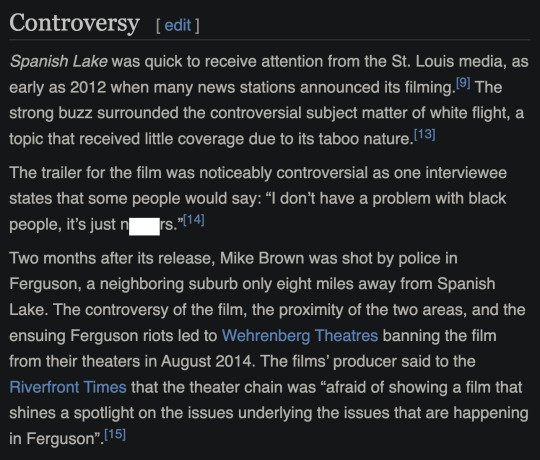
I started following a Facebook page dedicated to Spanish Lake, thinking it would be other folks in my community. I thought maybe I could get to know my neighbors.
Instead, it is all of the white people who moved away reminiscing about how great Spanish Lake used to be.

People in this group are trying really hard not to say the quiet part out loud.
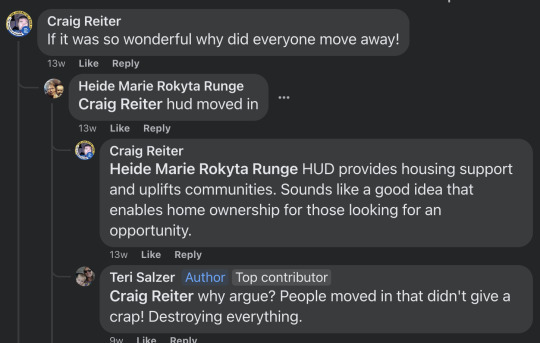

Riff raff?
Scot, I think you dropped this...

I grew up here. I still live here. I love my house and my street. There are some areas that could really use some help, but if you live here, you know the few small pockets to stay away from. I have no issue walking up and down my street at night without fear.
They also mourn the loss of the businesses that closed because they abandoned the area.
There is the mall which will be officially demolished soon.


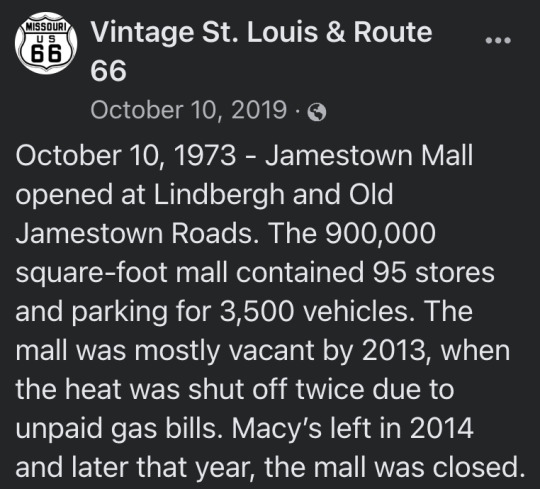
And, yes, it is the spooky mall from that viral video.
youtube
There was the movie theater... at the mall.

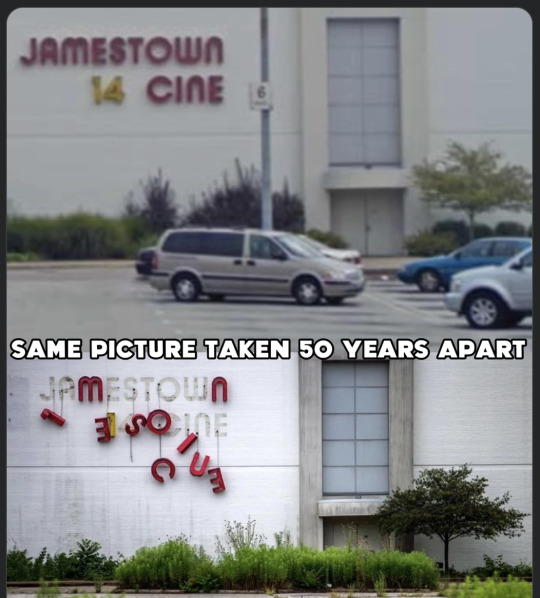
There was the Aloha Roller Rink.



Which now looks like this.


And the burger joint.
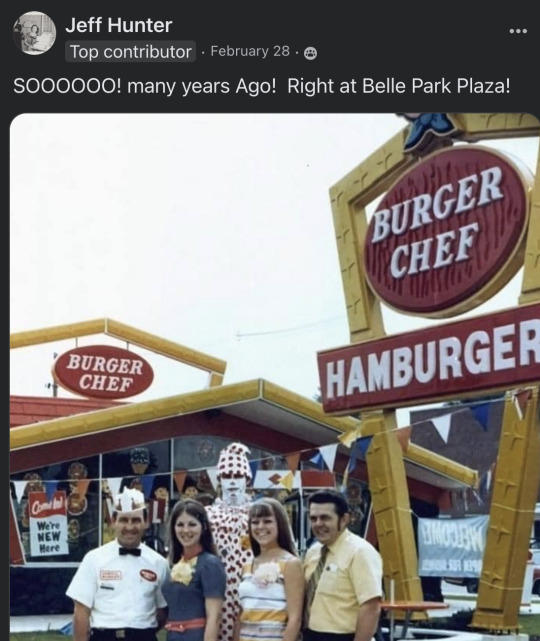
The pizza place.
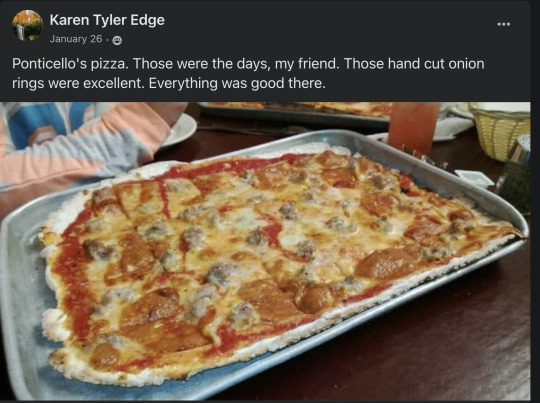
And the other pizza place.
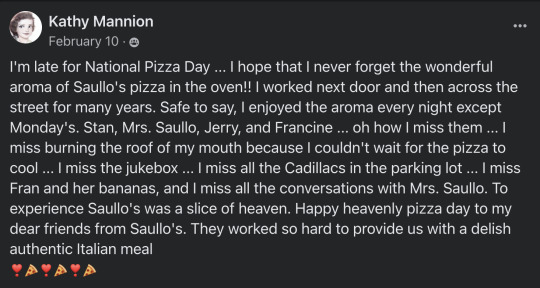

Saullo's was okay.
Angelo's in the next town over is better. And still in business!

What was I talking about?
Oh, yeah. Don't drive down unfinished roads!
39 notes
·
View notes
Text
Medalist - The Best Manga (Almost) No One Is Reading

“I want to strongly believe I can do it. I hate how much I know about the no-good side of me. I want to be more like the girl Coach Tsukasa believes in. I want to be someone I can believe in!”
Sometime last year, I was overhearing talk from manga bloggers/reviewers about a certain under-the-radar Kodansha title that deserves more attention. I later found out that it was licensed in the U.S. and also won several awards in Japan. This manga is about a sport that I’m not knowledgeable about (but has gained a lot of attention due to a anime series I’m sure people know called Yuri!!! on Ice!!), figure skating. This past week, I got to read the 1st 4 volumes of Tsurumaikada’s critically-acclaimed Medalist and finally saw what I was missing.
I don’t know a damn thing about figure skating, but I sure as hell know a great manga when I see it. And Medalist is just that.
Medalist focuses on the journey to become a competitive figure skater in Japan through the eyes of a child and her coach. The main character in question, Inori Yuitsuka, is a 5th grader who’s noted to be bad at everything in life so far except ice skating. However, she skates in secret as she has little access to skating rinks and she’s also considered to be “too old” to start competitive training. It isn’t until she meets her future coach, Tsukasa Akeuraji, that her life changes. Tsukasa had aspiring dreams to become a pro figure skater, but wasn’t able to due to starting at a later age. He becomes depressed over life due to not achieving anything significant in his figure skating career. When Tsukasa meets Inori, he realizes that she’s the same as him and decides to help her realize her dreams of becoming a pro figure skating medalist no matter what.
The art in this series is incredible. The figure skating scenes are well-done, but what really shines are the character interactions. Inori won the Magademy 2023 award for best female character and I can see why she won. She’s a kid who’s trying her damn best to challenge her insecurities via her passion for ice skating. I can’t help but be moved when Inori says something important to get her point across.
Tsukasa is a relatable character to those who feel lost at their hobby. As someone who feels like they started “late” for a competitive interest where it’s best to start young, I get where Tsukasa is coming from. This applies to my now-daily interest in Japanese mahjong. I’m well-past the general demographic (18-34) for the game in the U.S. as I started playing at the age of 38. There’s obviously certain barriers (mostly life responsibility-related), but I recently experienced the joy of helping a beginner get through a game in-person. I think, like Tsukasa, I want to at least help the next generation of mahjong players get started and find their paths to become better players.
Inori and Tsukasa’s relationship is amazing and well-written. Every great athlete needs a coach to bring out the best in them. However, if the coach/athlete relationship is based on how much an athlete wins, it will not go well. This becomes complicated when it comes to coaching children. With the exception of Inori being a 5th grader, Medalist focuses on aspiring 3rd grade figure skaters who are, for the most part, level-headed. But they all have personality quirks that can get in the way of achieving greatness. This manga does a great job in illustrating the coach/athlete dynamic when it comes to very young children. It’s something I don’t see in most media.
One of my favorite moments is in Volume 2 where Inori boldly tells her mother that she will get 1st place in a preliminary showing at a major cup and attempt techniques that appear to be hard for her. Inori’s mother didn’t really approve of Tsukasa getting her daughter into the world of pro figure skating at the start. But once she saw Inori look like an absolute gem in the making on the rink, she laments that she never thought of Inori’s feelings out of a fear of being hurt inside. I don’t know about any of you, but in my experience, my mother told me not to push myself so hard because of my mental limitations. She has told me not to try super-challenging jobs due to my depression. I think maybe she was trying to make sure she didn’t get hurt by my struggles and look like a bad parent to others. Part of it was also my own fault since I looked at the labeling I was prescribed a bit too seriously.
So yeah, seeing Inori’s mother know that Inori can actually do something meaningful with her life got me emotional. I do feel that some parents are really overprotective over their children and what they should be doing in life. I don’t blame them because failure over things that aren’t the norm will always be scary. Plus, not every dream will come true. Yet I know what every child wants from their parent is to believe in their ability to become whatever it is they want to be/do and that they’ll have their support no matter what. I wish more parents opened their eyes enough to see that.
I could go on and on about Medalist, but I’ll stop here. This is a fantastic series to read for anyone interested in relating to ambitious children and being there for them in realistic ways. Medalist is a bold story that details what it takes to create a winning environment for children, parents, and the communities around them.
#Medalist#Inori Yuitsuka#Tsukasa Akeuraji#manga#Tsurumaikada#figure skating#sports psychology#mental health
58 notes
·
View notes
Text
Intro to U.S. Agriculture Book Recommendations
Requested by @languagesandpain
Healing Grounds by Liz Carlisle
If you're interested in agroecology this is a great place to start. It highlights a handful of Black, Latino, and Asian American farmers and their lives, history, and research. It's a great all-around book too because it touches on animal agriculture, produce, and mushrooms (which I don't see get talked about much), and also different methods like agroforestry and pasture systems.
Grain by Grain by Bob Quinn and Liz Carlisle
This book is basically the story of Bob Quinn and his farm, there's a lot of good info in it. This is the first book that really struck home to me that I need to listen to people in conventional agriculture even if I personally don't like it, because there's important experiences that need to be heard. It touches on topics like converting farms to more sustainable methods, heirloom crops, and how we deal with food/diet related science in the US. I don't have any health issues of note, but after reading this book I found an organic bread with Kamut wheat in it to see how it was, and it totally takes away any white on my tongue when I'm eating it daily. Pretty fascinating.
Perilous Bounty by Tom Philpott
This book widely covers major problems in US conventional agriculture, mostly covering major agriculture corporations and environmental impacts but also some labor issues, and small/mid size farm struggles. I'm not going to lie, this one is depressing. I generally do well with tough topics but near the end I had to put it down a few times because it was making me feel a bit hopeless. Which I fault the author with a bit for not dealing with better, because we need more hope to be able to believe these problems are fixable. He also doesn't cover the eastern US which irks me a bit because the south is a major agricultural region. But overall, a lot of great info and some interesting ideas for solutions near the end.
With These Hands by Daniel Rothenberg
I haven't actually read this one yet, but I've read sections. It looks like another tough read, but covers the experiences of migrant farmworkers across the US. Definitely trigger warnings for modern day slavery, racism, abuse, and more.
Dirt: The Erosion of Civilizations
I found this one to be a bit pessimistic honestly, but I read it a while ago so I dont remember what exactly bothered me. But it's a good overview of agricultural collapse through history, soil science, and issues in soil today.
Lentil Underground by Liz Carlisle
(Can you tell I've read all of Carlisle's books yet). So this book didn't really make much of an impression on me. But I'm recommending it because if anything it kind of illustrates the tediousness of policy change, changing people's minds, running an unconventional farm. It's a bit boring compared to the other recommendations but if you're in the industry there's things to think about in it.
Non-book recommendations
For a while was listening to Real Organic Podcast. After about 10 episodes (not in order) you notice they start to really repeat a lot of ideas. But they have a lot of episodes that highlight problems with chemical use, water use, how movements like organic get co-opted by big corporations, and more.
I also recommend the news website Civil Eats. They post a lot of book recommendations, as well as cover a whole variety of agricultural issues across the world.
If anyone has any additional recommendations feel free to add on! I'm always looking for more books >:)
#not langblr#agriculture#agroecology#sustainable agriculture#regenerative agriculture#environmentalism#environmental justice#book recommendations
40 notes
·
View notes
Text
But hold on. What should it matter if some people are filthy rich, when even those who are the hardest up today are better off than the kings of a few centuries ago?
A lot. Because it’s all about relative poverty. However wealthy a country gets, inequality always rains on the parade. Being poor in a rich country is a whole different story to being poor a couple centuries ago, when almost everybody, everywhere was a pauper.
Take bullying. Countries with big disparities in wealth also have more bullying behaviour, because there are bigger status differences. Or, in Wilkinson’s terms, the “psychosocial consequences” are such that people living in unequal societies spend more time worrying about how others see them. This undercuts the quality of relationships (manifested in a distrust of strangers and status anxiety, for example). The resulting stress, in turn, is a major determinant of illness and chronic health problems.
Okay - but shouldn’t we be more concerned with equal opportunities than with equal wealth?
The fact of the matter is they both matter, and these two forms of inequality are inextricable. Just look at the global rankings: When inequality goes up, social mobility goes down. Frankly, there’s almost no country on Earth where the American Dream is less likely to come true than in the U.S. of A. Anybody eager to work their way up from rags to riches is better off trying their luck in Sweden, where people born into poverty can still hold out hope of a brighter future.
Don’t get me wrong – inequality is not the only source of hardship. It’s one structural factor that feeds into the evolution of lots of social problems and is intricately linked to a constellation of other factors. And, in point of fact, society can’t function without some degree of inequality. There still need to be incentives to work, to endeavour, and to excel, and money is a very effective stimulus. Nobody would want to live in a society where cobblers earn as much as doctors. Or rather, nobody living in such a place would want to risk getting sick.
Nonetheless, in almost all developed countries today, inequality far exceeds what could reasonably be deemed desirable. Recently, the International Monetary Fund published a report which revealed that too much inequality even inhibits economic growth. Perhaps the most fascinating finding, however, is that even rich people suffer when inequality becomes too great. They, too, become more prone to depression, suspicion, and myriad other social difficulties.
“Income inequality,” say two leading scientists who have studied 24 developed countries, “makes us all less happy with our lives, even if we’re relatively well-off.”
Rutger Bregman, Utopia For Realists: And How We Can Get There
11 notes
·
View notes
Text
QE is only used during MAJOR ECONOMIC DOWNTURNS to give a TEMPORARY boost to an economy already in freefall
Sep 17, 2024
NOTE TO READERS: The following is one of dozens of economic articles found in this week’s issue of The Trends Journal. Consider subscribing here for in-depth, independent geopolitical and socioeconomic trends and trend forecasts that you won’t find anywhere else.
By Gregory Mannarino, TradersChoice.net
On September 18, 2024, the Federal Reserve will officially announce that it is about to start cutting rates.
While in reality, the Federal Reserve is already DEEPLY involved in massive purchases of U.S. debt. (See chart below of the MMRI—Mannarino Market Risk Indicator). The MMRI is free for everyone and can be viewed here.
Here in the chart below, note the upward trend (black lines), was broken (red arrow/circle), in early June. This denotes where the Fed began to aggressively buy/monetize debt.
Monetizing the debt is defined as when a central bank, in this case the Federal Reserve, uses newly created currency to buy bonds/Treasury bills.
This process is also called Quantitative Easing.
The result of Quantitative Easing/QE directly affects bond yields, causing rates to drop. QE is also extremely currency purchasing power negative.
Using today as an example. As no “official” announcement has yet been made by the Fed that they are already cutting rates, mortgage rates here in the U.S. have now dropped to a nearly 2-year low.
Moreover, just this past week the yield curve here in the U.S. just came out of its longest inversion cycle in history. This is known as YIELD CURVE CONTROL. Yield curve control is a “tool” used by central banks to manage interest rates. More specifically, to stabilize long-term interest rates, like mortgages for example as we are seeing today.
QUANTITATIVE EASING IS EMERGENCY MONETARY POLICY!
QE is only used during MAJOR ECONOMIC DOWNTURNS to give a TEMPORARY boost to an economy already in freefall.
Because QE involves the VAST creation of “new money” which is then used to buy/monetize the debt and therefore keep interest rates artificially suppressed, QE is highly destructive to the purchasing power of the currency-therefore QE is highly inflationary.
Just this past week here in the U.S., and this is also a worldwide phenomenon, the repeated round after round of bad economic news continues. Most recently, new jobs hiring here in the U.S. just hit A HISTORIC LOW. And just two weeks ago, according to the BLS, 818,000 jobs just “vanished.”
With factory activity and U.S. manufacturing remaining in contraction, the U.S. trade deficit continues to hyperinflate. Meanwhile, they want us to believe that the U.S. unemployment rate fell to 4.2 percent?!
During the Great Depression, at its peak, the U.S. unemployment rate was 24.9 percent. If we were to use the same metrics to measure unemployment today, as they did during the peak of the Great Depression, the U.S. unemployment rate would be FOUR TIMES HIGHER than the fake numbers that the mainstream media is putting out today.
The fact is this. Today we stand on the threshold of THE GREATEST DEPRESSION on a global scale. And to ensure that this Greatest Depression does happen, you can expect that both Presidential ‘selectees” here in the U.S. will continue to sell you the same narrative when it comes to the financial system.
These Presidential Selectees will continue to promise you lower rates, which of course means an even weaker dollar. Their calls/promises of lower rates will allow the Fed to VASTLY inflate AND MONETIZE the debt even more! Further assuring that the Federal Reserve will attain even MORE power and control over all of us
6 notes
·
View notes
Note
Hmm I was watching this video https://youtu.be/DHF8LdiFhW8?si=U3QcuoufihSLEONt
And in the comments they pointed out that parents of the 50’s were children on the Great Depression. Which got me thinking
As you know a lot of people who came from poverty goes crazy when they get famous or successful. The…black community is like that as we can barely comprehend so much wealth at once. Not all as many are slick enough to start their own record labels, clothing, etc.
But that comment got me thinking about the great generation. I can only imagine how crazy they went with the fact they grew up in the Great Depression and then boom the USA is on top of the world. Then they sent their kids to college who got brained that Kinsey studies was good for society.
Yes I know the previous generations prior to boomers had libidos, I mean look at Walt’s and his colleagues/competitors works when the female body got more defined in cartoons.
But we really need to look into the boomers upbringings and their parents prior to prevent another one.
youtube
I wish this was the stawman it looks like but I've seen this all before on here.
Wonder if they'd be terribly shocked at how much "GAY" was ignored in the 50's and beyond.
Couple of teachers at the Christian (ND but Pentecostal run) school I went to, ladies that had a duplex they rented next to each other and always had neither one married or dated that anyone knew of and they were just "really good friends" and had been forever. Both taught 5th grade too.
Didn't even click for me what was likely going on till I was in my 20's and they drifted into my head for some reason, but ya that was in the 80's that was going on.
The arguments about divorce and women not having their own bank accounts honestly hold a lot more water.
The…black community is like that as we can barely comprehend so much wealth at once. Not all as many are slick enough to start their own record labels, clothing, etc.
Herb from "Peaches and Herb" was working well here
"Once again, Fame returned to law enforcement and joined the U.S. Marshals Service in 1986 as a deputized court security officer at the U.S. Court of Appeals for Veterans Claims."
Big part of that I think was him getting shafted on royalties, but initial payouts still should have kept him comfortably middle class for life after the 3rd peaches.
Then we have MC Hammer and Mike Tyson, though being shit with handling money and the fame that comes with it isn't exclusive to any one group regardless of the demographic they're in.
Thankfully the lawyers and accountants are getting better at convincing people to knock it the fuck off so we don't wind up with.
To be fair to Willie his accountants had screwed him and there were some bad investments, oversight of accountants is also part of the bit above this with the getting them to knock it the fuck off part.
Ted Nugent ran into similar, but the accountants had made some really bad investments instead of just flat out not paying his taxes for years.
But ya guys like Dre, Jay Z, Beyonce, and Rhianna from that end of the spectrum have done very well, Michael Jackson for all his eccentricity made some great investments that should be enough to keep his grandkids doing wonderfully even. (as long as they still have half the Beatles catalouge at least)
As for libidos, we been horny since the dawn of horns it got played down some round WW1 or so and people started to reset their memories, there's some nasty stuff out there from the Victorian to Edwardian ages.
7 notes
·
View notes
Text
Is there anything better than curling up with a warm slice of banana bread topped with a slab of butter? Turns out, yes! My desire to combine some of my favorite American classics with Jewish confections led to the creation of banana bread babka.
The exact origins of banana bread are unknown, but it is believed to have gained in popularity during The Great Depression as a way to decrease food waste from tossing overripe bananas, though some would argue it was developed to sell more baking soda. This might explain why it became the quintessential at-home treat at the start of the COVID pandemic, when people were limiting their visits to the grocery store and spending lots of time indoors. While I baked my fair share of loaves during the pandemic, as the world began to open up, I wanted to elevate banana bread. The fluffy texture of the babka dough and ribbons of cinnamon-spiked brown sugar running through this banana bread babka are a definite upgrade, but still honor the original recipe.
While babka is more time-consuming and complex than banana bread, the two have a lot in common. They’re both cakes with a long history that have risen to fame in the U.S. in the past decade, and they both use yeast as a leavening agent. This dough needs to rise for at least eight hours; you can also make it the day before and leave it to rise overnight.
Serve this banana bread babka alone, topped with butter or jam, or my personal favorite: topped with caramelized banana slices.
Note: As this recipe makes two loaves, I like to keep one for myself and give one to a friend as a gift. You can also freeze the second loaf while you make your way through the first. Store in the freezer for up to a month. To thaw your frozen loaf, allow it to defrost on its own by letting it sit out on the counter overnight.
15 notes
·
View notes